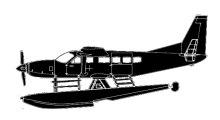Incident Overview

Description
A float-equipped Cessna 208 Caravan I, operated by Greenpeace Brazil, suffered an accident while attempting to land on the Rio Negro river in the Anavilhanas National Park near Manaus in Brazil. The aircraft touched the water with its landing gear extended and it overturned. One of the passengers sustained fatal injuries. 2 Contributing factors. – Attitude – a contributor. Failure to comply with the checklist during the pre-flight inspection and the flight itself favored the landing with inadequate configuration. This attitude may have been triggered by the pilot’s confidence in his operational capability, because of his long experience in aviation. – Flight indiscipline – a contributor. Failure to comply with the checklist indicated, in addition to the low level of situational awareness, a low level of concern for the safe conduction of the flight by failing to follow basic procedures set forth in the manufacturer’s manuals and current regulations. – Piloting judgement – a contributor. The pilot’s choice not to use the checklist during the flight phases revealed an inadequate evaluation of parameters related to the operation of the aircraft. Improper compliance with the items in the Pre-Flight Inspection Sheet prevented the AMPHIB PUMP 1 and 2 circuit breakers from being rearmed. – Aircraft maintenance – a contributor. After performing the test of landing gear extension and retraction by the emergency system, the AMPHIB PUMP 1 and 2 circuit breakers were not rearmed, being the aircraft delivered to fly in this condition The setting recorded on the AIRSPEED switch of the landing gear position warning system computer demonstrated that the scheduled speed of 74kt was not in accordancewith the recommended in the 9600-1A installation manual of Wipaire Inc. in its revision G. – Memory – undetermined. The AMPHIB PUMP 1 and 2 circuit breakers were found disarmed after the occurrence, indicating that, after the completion of the maintenance service, the executor of the tasks probably forgot to comply with the procedures for reconfiguring the aircraft. In addition, it is possible that the pilot’s automatism in relation to his way of carrying out the air operations, without the use of the checklist, has prevented the correct perception of the circuit breakers condition and the erroneous positioning of the landing gear. – Perception – a contributor. The accomplishment of the landing on the water with the aircraft in inadequate configuration for the situation denotes a decrease in the level of situational awareness of the pilot, considering that the necessary factors and conditions for the safety of the operation were not observed.
Source of Information
http://www.greenpeace.org/brasil/pt/Noticias/aviao-utilizado-pelo-greenpeace-brasil-sofre-acidente-rio-negro/, http://www.acritica.com/channels/manaus/news/hidroaviao-cai-no-rio-negro-com-passageiros-a-bordo-proximo-a-manaushttp://www.greenpeace.org/brasil/pt/Noticias/aviao-utilizado-pelo-greenpeace-brasil-sofre-acidente-rio-negro/, http://www.acritica.com/channels/manaus/news/hidroaviao-cai-no-rio-negro-com-passageiros-a-bordo-proximo-a-manausPrimary Cause
Failure to comply with pre-flight checklist procedures and a lack of situational awareness, leading to inadequate landing configuration and a subsequent accident.Failure to comply with pre-flight checklist procedures and a lack of situational awareness, leading to inadequate landing configuration and a subsequent accident.Share on:



